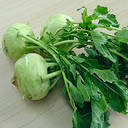Kohlrabi, another valuable vegetable from the Brassica genus, is a biennial grown as an annual. Although it is often classified with the root vegetables, the above-ground bulb is actually the swollen base of the stem, which sits right at soil level. Its name is from old German and Swiss German for 'cabbage turnip'.
Botanical Name: Brassica oleracea var.gongylodes. Also called: German turnip, stem turnip. Varieties/Cultivars: Grand Duke, Gigante (also called Superschmeltz), Purple Vienna, Early White Vienna, Kolibri, Kongo, Purple Danube.
Kohlrabi’s origins are uncertain, but it is mentioned in the first century AD in Imperial Rome, and is listed in recipes by Apicius, who wrote the oldest known cookbook. It traveled to Northern India in the 1600's where it quickly became an important dietary staple in Kashmir. Its popularity then spread south through the subcontinent. Kohlrabi is now grown in many parts of the world, including Asia and North America.
Hardiness Zone: 3B – 10A (Vancouver is 6A-8A)
Harvest (from direct seed): 55-65 days
Size at Maturity: 6 - 8" h by 3 - 5" w
Planting Dates: Mid July - Late August
Harvest Dates: Early September, November - January
Ideal Site & Soil
Kohlrabi is a moderate to heavy feeder that needs rich humus soil amended with composted manure. Like all Brassicas, it grows best in soil that is moist and well-drained with an optimum pH range of 6.0-7.0. Mix approximately 1 cup of complete organic fertilizer into the soil under a 10 ft row at seeding. Keep soil moist with even watering, and mulch well. Plant in full sun unless you are starting your seed early, then plant next to taller plants so the emerging seedlings will have partial shade from the late summer sun.
Cultivation / Plant Care
Kohlrabi is mature when bulbs are about 2-3 inches in diameter. It can be planted in the early spring but if it reaches maturity in hot weather inferior bulbs are produced. This makes kohlrabi an ideal, fast-growing food for the autumn and winter garden.
In good soil kohlrabi is an undemanding plant. A mid-season feed of compost or green manure will keep the autumn crop growing steadily. Late planted, kohlrabi will stand several months without going woody. Feed a late planting before everything slows down in late October.
Problems & Pests
Like other Brassicaceae family members, kohlrabi is subject to problems with cutworms, cabbage butterfly larvae, leaf miners, caterpillars, and root maggots. By using a floating row cover atop your crop these threats will be reduced or avoided.
White rust, downy mildew, and powdery mildew are common Brassicaceae diseases. If these have been prevalent in your garden, plant kohlrabi in an area that has not had Brassicas grown in it for at least four years. For remedies, see the notes on pests and problems in the general information sheet on Brassica crops (available under Resources tab on the main website).
Harvest Notes
Keep an eye on early-planted kohlrabi because bulbs can become tough and woody if left too long in the ground. Late planted kohlrabi is far less prone to woodiness, is frost hardy, and may well last well beyond Christmas.
Nutrition & Recipes
Raw, kohlrabi’s white turnip and apple flavour has a touch of radish finish, making it a good addition when grated into a salad. Steamed or roasted, it is milder, and fits into many different cuisines. The smaller leaves are eaten as cooked greens. Kohlrabi is low in calories (19 for ½ cup raw, sliced), and high in dietary fibre (2.5 grams for ½ cup). A half cup contains 16 mg. of calcium, 245 grams potassium, 25 I.U. Vitamin A, 43 mg. Vitamin C, and 11 mcg of folic acid.
Roasted Kohlrabi
Ingredients:
- 4 kohlrabi bulbs, peeled
- 1 teaspoon olive oil
- 1 clove garlic, minced
- salt and pepper to taste
- ⅓ cup grated Parmesan cheese
Directions:
- Preheat oven to 450 degrees F (230 degrees C).
- Cut kohlrabi into ¼ inch thick slices, then cut slices again in half.
- Combine olive oil, garlic, salt and pepper into a large bowl.
- Toss kohlrabi slices into the mixture to coat.
- Spread slices in a single layer on a baking sheet.
- Bake in preheated oven until browned (15-20) minutes, flipping over at about 10 minutes so slices brown on both sides.
- Remove from oven, and sprinkle with cheese. Return to oven for 5 minutes to brown the cheese.
- Serve immediately.
Author: Rachelle Siddall, MGIT, Vancouver Chapter





